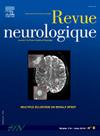Neurological damage from recreational nitrous oxide use: Two distinct electroclinical profiles in a retrospective cohort
IF 2.3
4区 医学
Q2 CLINICAL NEUROLOGY
引用次数: 0
Abstract
The recreational nitrous oxide (N2O) use is increasingly recognized as a cause of serious neurological disorders, particularly among young individuals. This retrospective multicenter study aimed to describe the clinical, biological, and electrophysiological features of 41 patients with neurological impairments linked to recreational N2O use. Most patients presented myeloneuropathy and motor-dominant, length-dependent, axonal neuropathy involving the lower limbs. Notably, two distinct electroclinical patterns emerged from nerve conduction studies and electromyography: a predominant sensorimotor axonal neuropathy (78.4% of cases) and a pure motor neuropathy (13.5%), both primarily involving the lower limbs. Despite normal serum B12 levels in most cases, elevated homocysteine and methylmalonic acid levels confirmed a functional vitamin B12 deficiency. These findings highlight the characteristic electrophysiological profiles associated with recreational N2O use and underscore the importance of early detection and targeted management to prevent long-term disability.
娱乐性氧化亚氮的神经损伤:回顾性队列中两种不同的电临床特征。
娱乐性氧化亚氮(N2O)的使用越来越被认为是导致严重神经系统疾病的原因,尤其是在年轻人中。本回顾性多中心研究旨在描述41例与娱乐性N2O使用相关的神经损伤患者的临床、生物学和电生理特征。大多数患者表现为脊髓神经病变和运动主导型、长度依赖性、轴索神经病变累及下肢。值得注意的是,神经传导研究和肌电图显示了两种不同的电临床模式:主要是感觉运动轴索神经病(78.4%的病例)和纯粹的运动神经病(13.5%),两者主要累及下肢。尽管大多数病例的血清B12水平正常,但同型半胱氨酸和甲基丙二酸水平升高证实了功能性维生素B12缺乏症。这些发现强调了与娱乐性N2O使用相关的特征性电生理特征,并强调了早期发现和有针对性的管理对于预防长期残疾的重要性。
本文章由计算机程序翻译,如有差异,请以英文原文为准。
求助全文
约1分钟内获得全文
求助全文
来源期刊

Revue neurologique
医学-临床神经学
CiteScore
4.80
自引率
0.00%
发文量
598
审稿时长
55 days
期刊介绍:
The first issue of the Revue Neurologique, featuring an original article by Jean-Martin Charcot, was published on February 28th, 1893. Six years later, the French Society of Neurology (SFN) adopted this journal as its official publication in the year of its foundation, 1899.
The Revue Neurologique was published throughout the 20th century without interruption and is indexed in all international databases (including Current Contents, Pubmed, Scopus). Ten annual issues provide original peer-reviewed clinical and research articles, and review articles giving up-to-date insights in all areas of neurology. The Revue Neurologique also publishes guidelines and recommendations.
The Revue Neurologique publishes original articles, brief reports, general reviews, editorials, and letters to the editor as well as correspondence concerning articles previously published in the journal in the correspondence column.
 求助内容:
求助内容: 应助结果提醒方式:
应助结果提醒方式:


